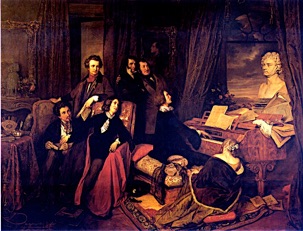Historically Informed Performance Practice (HIP)

Have you ever wondered what it would have been like, to be in imperial Vienna listening to Beethoven and Schubert, or in an elegant Paris salon, deeply moved by the playing of Franz Liszt and Frederick Chopin? How did they play? Like us, just better of course, or ... quite differently? Have the great changes in culture between earlier centuries and our own time also changed the way we play? And if so, does it matter? Does it change or even damage the music? These questions lie at the heart of the historically informed performance movement, or HIP for short.
Some of us, scholars and performers, have been gripped by these questions for many years, and we’ve found out a great deal. In particular, the evidence of C19th Romantic style contains a unique source, a musical TARDIS full of amazing early recordings from the beginning of the 1890’s, including by composers, and by students of composers like Liszt and Clara Schumann. We’ve found that our style of performance has changed nearly as much as our styles of composition. Since around the 1930s, we have in fact been applying a modernist style of playing not only to modernist repertoire, but to romantic and classic era works as well.
So, what have we found out in romantic style? Briefly, a much freer style of playing. Music scores are often changed, sections are repeated or cut, textures thickened, and phrases ornamented. Rhythm is much freer, more declamatory, flowing and swinging this way and that, or momentarily stopping for a breath. Chords are often broken one note at a time, and hands are often deliberately out of sync. All this creates a more improvisatory feel. More like jazz.
What about the future? The HIP movement is expanding, and has grown from a small group of somewhat eccentric pioneers to become mainstream in certain performance styles. As late as the 1970s for example, it was still possible to perform baroque music using the modern piano as solo or continuo (I remember playing Bach arrangements of Vivaldi concertos this way!). Yet since the 1990s almost no one, soloist or ensemble, has been able to perform in a major venue without using at least a harpsichord, gut strings, perhaps baroque reproduction brass and wind instruments, and most importantly, without applying significant elements of HIP baroque style.
And today, it’s already becoming difficult to credibly perform classic era repertoire (Haydn, Mozart, Beethoven) on modern instruments using modernist performance style. Romanticism is next, and in at least one way should be easier to reanimate: the difference between 19th century period and modern instruments is less (though still significant), and my experience is that HIP romantic style works just fine on modern instruments.
You can listen to a short 30 minute HIP recital I recorded at home during the Covid lockdown for Bootham School (York), using my 1864 Érard piano: https://youtu.be/TTID6FGSR9Y

